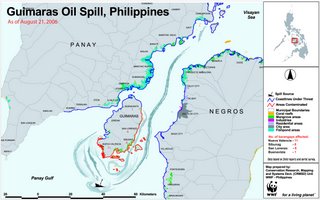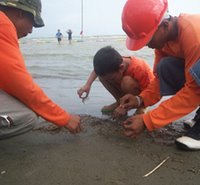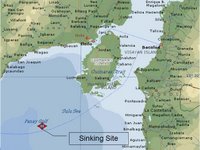Was There Ever a Question?
Was there ever a question, who was at fault? Government probers found shipping firm Sunshine Maritime Development Corp. (SDMC), Captain Norberto Aguro, Petron Corp., and maritime officials liable for the sinking of the ill-fated MT Solar I. The Department of Transportation and Communication (DOTC), after scrutinizing the report of the Board of Marine Inquiry (BMI), announced Thursday that Petron was "liable of overloading" industrial fuel at its port in Limay, Bataan. Overloading caused "instability" to the MT Solar I and "render[ed] it unseaworthy for the voyage," the report said.
The MT Solar I was carrying some 2.2 million liters of bunker fuel when it sank off Guimaras Island in central Philippines on August 11. Some 200,000 to 300,000 liters of oil had been spilled into the sea, devastating the coastal villages in at least three provinces. However, evidence of a continued oil leak was observed during the recent weeks. Captain Norberto Aguro, skipper of the ill-fated tanker, was found "administratively liable of disabling lack of adequate training for oil tankers." The report also said Aguro failed to "exercise due dilligence in making the vessel seaworthy." Sunshine Maritime, meanwhile, was deemed "administratively liable for completely disregarding all mandated regulations" for the seaworthiness of vessels.
The investigators left it to the Department of Justice to determine the civil and criminal liability of the Petron, Sunshine Maritime and Aguro. DOTC Secretary Leandro Mendoza directed the Marina to file charges against the three parties. The Maritime Industry Authority (Marina) and the Philippine Coast Guard, meanwhile, supposedly "committed lapses" in performing its mandated functions.
The investigators left it to the Department of Justice to determine the civil and criminal liability of the Petron, Sunshine Maritime and Aguro. Mendoza also directed the Marina to file charges against the three parties. The Maritime Industry Authority (Marina) and the Philippine Coast Guard, meanwhile, supposedly "committed lapses" in performing its mandated functions.
Why M/T Solar 1 sank
The sinking of the MT Solar I was attributed to three key factors: (1) loss of residual stability or overloading, (2) loss of reserved buoyancy due to bad weather, and (3) the captain's "incomptence."
1. Overloading caused "instability" to the MT Solar I and "render[ed] it unseaworthy for the voyage," said DOTC Sec. Leandro Mendoza, who read the report findings. The MT Solar I was carrying some 2.2 million liters of bunker fuel when it sank off the Guimaras Island in central Philippines last August 11. The board, chaired by Rear Admiral Danilo Abinoja of the Coast Guard, reported that the sea vessel was overloaded by approximatedly 150 tons.
2. MT Solar I was also unable to properly stay afloat because its loadline, or the markings which show its safe buoyancy level, was "adjusted" from 1,220 mm to 700 mm. When the vessel sailed into rough seas during its final voyage, the forward compartments and top deck was flooded with seawater by an aggregate volume of 275 tons. "Bad weather and prevailing Southwest Monsoon and the probable flooding" of two ballast tanks was enough to force the vessel to turn "upside down," the report read.
3. Despite his best efforts to convince the panel, Aguro was found "lack[ing] of adequate training, a disabling error of judgement and a disabling lack of knowledge." Aguro, who had been seafaring for the past 25 years, had insisted that his chemical tanker operations license was secured before the government put up requirements for oil tanker operations. However, the Marina noted during one hearing that Aguro's licence with the Professional Regulation Commission (PRC) was already expired as of 2002. Captain Norberto Aguro, skipper of the ill-fated tanker, was found "administratively liable of disabling lack of adequate training for oil tankers." The report also said Aguro failed to "exercise due dilligence in making the vessel seaworthy." Sunshine Maritime, meanwhile, was deemed "administratively liable of completely disregarding all mandated regulations" for the seaworthiness of its vessels.
As for the culpability of the Coast Guard and the Marina, Mendoza is expected to issue an order within the coming days calling for the formation of a new panel to determine the agencies' shortcomings. Abinoja said the new body will "look at the lapse within institution" of the maritime authorities. The panel will be headed by Cecilio Penilla, DOTC undersecretary for transport security. Abinoja said it will be given 30 days to complete its investigation.
BMI member Commodore Benjamin Mata told GMANews.TV that, "the report shows the independence of special Board of Marine Inquiry because the members were able to see the lapses of the Marina and the Coast Guard desptie the fact that our chairman is the deputy commandant of the Coast Guard and our vice chairman (Primo Rivera) is from the Marina."
Oil Smuggling?
The SBMI started its inquiry on August 29 and invited 19 resource persons from the MT Solar Icrew, Sunshine Maritime, ship inspection firms, Petron, a life raft supplier and the Marina. During the hearings, some BMI members noted that a hole on the side of the MT Solar I may have been punctured by another boat, raising suspicions that Sunshine Maritime was involved in oil smuggling. However, the conduct of such a crime was not among the findings released Thursday. Still, the BMI said it would ask the National Police and National Bureau of Investigation to look into the matter. GMANews.tv, Thursday, September 14, 2006






